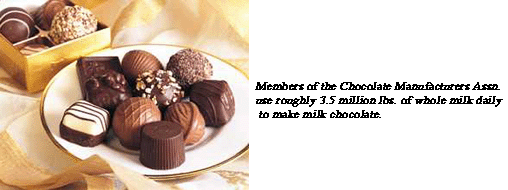Dairy: indulgence's not-so-secret weapon

By Bill Haines, Dairy Management Inc.
Contents
Getting the scoop
How sweet it is
Protein properties
Frozen decadence
Comforting indulgence
Indulge freely
Indulgence. A personal reward for a harried, frantic lifestyle. The word conjures up smiles and pleasant images, as one can imagine sinking into soft, billowy sofa cushions, with fork or spoon poised to take the first bite of a luxuriant treat, in response to a hard day's work.
Indulgence isn't necessarily the antithesis of a healthy lifestyle. Americans spent much of the past three decades eliminating many good-tasting foods from their diets based on the latest health reports. After listening to constantly conflicting news about the virtues or flaws of various foods, consumers staged a revolt and discovered moderation. Even diet centers and programs approve of their patrons occasionally indulging in a flavorful, rich dessert or snack. Consumers who do so find that a balanced lifestyle includes not only enjoyable physical activities, but also enjoyable meals and tasty treats that provide a lift to the psyche and offer an island of pleasure in a sea of obligations.

The strong economy also has played a role, giving American consumers the economic power to pamper themselves, resulting in higher expenditures on sweet snacks, entertaining and indulgences. Food manufacturers have responded to this increasing interest in indulgent treats by offering a wide variety of options. Grocery store shelves and freezer aisles offer a tempting array of rich cheesecakes, premium ice creams, flaky strudels, sweet chocolates and confections, moist cakes, and home-style pies and cookies.
The rich, homemade flavor and pleasant texture of many of these carefully crafted foods stems from a creative blend of natural, wholesome ingredients such as dairy. Moist cakes and premium ice creams rely on dairy ingredients to lend the freshness and flavor consumers crave while also giving food formulators functionality and clean labeling.
From Sara Lee Chocolate-Dipped Praline Cheesecake Bites to new Jell-O Desserts Delights and Edy's new M&M, 3 Musketeers, Snickers and Twix Ice Creams, dairy ingredients appear on thousands of package ingredient lists, and for good reason.
Getting the scoop
No matter how it's scooped, Americans love ice cream. Ice cream and related frozen desserts were consumed by nearly 91% of U.S. households in 1999, with Americans eating 23.75 quarts of ice cream per person, according to the International Dairy Foods Assn.
Ice cream and other frozen dessert sales totaled $11.5 billion in 1999, up 2.9% from 1998, according to a study released by MarketResearch.com. The biggest seller in the frozen dessert category is packaged ice cream, capturing more than 52% of sales in 1999, for a heaping $6 billion.
Dairy ingredients represent the backbone of ice cream manufacturing. Although some consumers look for lower-fat alternatives, the indulgent, rich and creamy premium flavors still lead the pack. In fact, the highest supermarket sales increases in 1999 stemmed from the premium and super-premium brands, according to IDFA, and gallons of super-premium ice cream sold grew 14% in 1999 vs. 1998.
MarketResearch.com states that positive and negative factors affect this market growth, including cooler weather patterns, health-conscious consumers, the Baby Boom echo, the U.S. economic boom and globalization of economy and culture. The latter is evidenced by the introduction of flavors popular in Eastern Europe, Asia and Latin America, such as dulce de leche, a caramel flavoring appearing in ice creams and frozen dessert selections.
The economic boom gives greater buying power to various segments within the broader population, and market segmentation targeting different ages and ethnic groups capitalizes on this factor. Product trends to look for include a continuing demand for full-fat premium and super-premium products, with varieties and flavors targeting the spectrum of demands within different population segments.

Traditionally, milkfat has been considered the source of premium flavor and texture consumers seek, Dairy Management Inc. But the dairy proteins found in abundance in whey and nonfat dry milk are proving to be the real workhorses of high-quality ice cream production. Dairy proteins attach themselves to fat globules during homogenization and to air bubbles created during whipping and freezing. In effect, they create microscopically thin, uniformly sized "protein balloons" that trap and separate fat and air throughout the frozen mixture. This behavior, called "surface activity," aids in emulsification, whipping and foaming.
Dairy proteins help stabilize a frozen product's body, texture and resistance to changes induced by heat shock. The physical characteristics of the emulsion are what helps ice cream maintain its shape and slows its dripping when exposed to the heat of a warm summer day. Stability is essential when creating extruded novelty items, such as ice cream sandwiches and bars. The right balance of dairy ingredients also determines the smooth texture in those lofty, deliciously whipped soft-serve products.
Important as they are, dairy proteins aren't the only contributors to ice cream quality. The lactose and minerals in dairy ingredients also play important roles. Lactose has a freezing point depressing factor of one relative to sucrose, and a sweetness of 0.3 relative to sucrose. Lactose is an important filler that can be used up to a level of 7.5% without causing sandiness. Minerals such as calcium add nutritional value. Whey ingredients generally contain more minerals and function well in a lower pH product such as a fruit sorbet or smoothie. Often, a demineralized whey or whey protein concentrate is used to impart a cleaner flavor profile in a higher pH product.
Dairy ingredients are key to the success and great taste of any ice cream, but marketers also are finding that unique products also influence consumer purchasing decisions. One such product is candy bar ice cream, such as those recently introduced by Edy's, which include M&M, Milky Way, Twix and 3 Musketeer's.
How sweet it is
Candy bar ice cream might be new, but the consumption of confections goes back years. In fact, Richard Cadbury introduced the first box of chocolate in 1868, when he decorated a candy box with a painting of his young daughter holding a kitten in her arms. Cadbury also invented the first Valentine's Day candy box. However, gone are the days when a bon-bon moment was reserved for Feb. 14 or other special occasions.
Americans indulged in confections at a per capita rate of 25.2 lbs. in 1999, according to the National Confectioners Assn. and the Chocolate Manufacturers Assn. That equals nearly 7.3 billion lbs. of candy. And the trend is expected to continue. In fact, a recent study conducted by MarketResearch.com projects that retail sales of candy and gum will grow at a rate of nearly 5% annually, reaching $27 billion by 2004.
This is great news for confectioners and the dairy industry. Dairy ingredients always have been important to the confectionery industry. As proof, consider that members of the Chocolate Manufacturers Assn. use about 3.5 million lbs. of whole milk daily to make milk chocolate. Over the course of a year, that equals close to 1.3 billion lbs. of milk. The names Milky Way, Milkduds, Milkfuls and Hershey's Milk Chocolate proudly proclaim the importance of their dairy components. The fat, protein and sugar contents of various dairy ingredients all contribute flavor and function in conventional confectionery applications.
Milkfat primarily provides flavor, improves texture and adds gloss to confections. More than 120 different compounds exist that contribute to milkfat's unique flavor. Butter melts over a wide range of temperatures, but most milkfat fractions melt when they reach human-body temperature. Thus, the addition of milkfat to cocoa butter has a softening effect and prevents the "waxy" mouthfeel of vegetable fats. Milkfat also affects the crystallization of other fats such as cocoa butter, and acts as an emulsifier via its phospholipids and lipoprotein components. It even can be fractionated to provide very specific taste and texture properties. Even a small addition of milkfat will inhibit bloom associated with long-term storage of chocolate.
Milkfat fractions are created through a physical process called dry crystallization, which separates milkfat into fractions based on their melting points. It is the high melting fraction, with a melting point greater than 40 degrees Celsius, that provides extra bloom inhibition.
Richard Hartel, Ph.D., a researcher at the food science department of the University of Wisconsin-Madison and Wisconsin Center for Dairy Research, concentrates his studies on milkfat fractions and the effect on confectionery formulation.
"We know that high-melting milkfat fractions (HMF) inhibit fat bloom during chocolate storage, but no one knows exactly why," Hartel said. "Inhibition of bloom may be related to the presence of certain components in milk, which may be concentrated in the HMF. These components may be high-melting, trisaturated triacylglycerols or the more polar lipid components.
"However, our understanding of the mechanisms of fat bloom formation in chocolates is still not complete, and it is unclear how these milkfat components affect the mechanisms of bloom formation," he said. "Further work is necessary to truly customize milkfat fractions for use as bloom inhibitors."
Protein properties
The proteins in dairy ingredients also provide important flavor and functional properties to confections. Their amine groups react with lactose and other reducing sugars to form important color and flavor components through the Maillard reaction. Milk proteins function to stabilize foam, impart chewiness, bind water and provide stand-up properties in many toffee, caramel and similar confections. Whey protein concentrates find uses in marshmallow-type confections where they can partially replace gelatin.
"The whippability of high-protein whey ingredients make them well-suited for marshmallow and nougat-type fillings," said K.J. Burrington, coordinator of the whey applications program, Wisconsin Center for Dairy Research at the University of Wisconsin-Madison.
Lactose, or milk sugar, is another important component of dairy ingredients and plays a vital role on nonenzymatic browning. Its low sweetness (only 0.3 times that of sucrose) and solubility (one of the lowest among disaccharides) allows partial substitution for sucrose on many confectionery applications.
"Because of their lactose and protein content, dried dairy ingredients contribute a rich, brown color and sweet brown flavors to confections like caramel and toffee," Burrington explained.
In addition to providing flavor and functional properties, dairy ingredients also can save confectioners money. Concentrated and dry milk ingredients improve water binding in candy, helping to reduce the cost of confections (since water is an inexpensive ingredient). Milkfat is one of the few fats highly compatible with cocoa butter. Therefore, it can replace portions of cocoa butter in many indulgent confectionery formulations, offering considerable cost savings. And a substitution of 10% to 20% lactose for sucrose can impact a manufacturer's bottom line.
If any doubt exists that indulgence is in, check the candy aisle. Russell Stover Candies offers consumers a variety of rich decadent delights, including Pecan Delights and Almonds Delights.
"In most of our caramels, Pecan Rolls and Delights, we use cream and condensed milk," said Tom Ward, president/COO of Russell Stover Candies, the third-largest U.S. chocolate company. "Dairy components are used because they are the most important ingredients that give our candy the flavor and texture required to make them taste good."
Milky Way has a new product out called Milky Way Midnight Bar, described as "bold rich chocolate, golden caramel and vanilla nougat" and loaded with dairy products including milkfat, skim milk and lactose.
Frozen decadence
From cheesecakes to cherry pies, the frozen dessert category also is experiencing a sales rebound, due in part to an increased appreciation by consumers of high-quality, indulgent foods. Frozen pies represent a prime example.
Annual dollar sales of frozen pies were at $386.4 million for the 52-week period ending April 2000, a 4.2% jump over the previous 52-week period, according to Information Resources, Inc.
One general market trend in frozen desserts is anything branded, especially with candy bar and cookie brands. These inclusions provide visual appeal, while offering consumers the ultimate in texture and taste sensation.
Mrs. Smith's pies recently introduced its new line of Cookies & Cream products, co-branded with Keebler, which includes the Droxie's Cookie & Cream Pie made with nonfat milk. Another top indulgent performer of theirs is The Restaurant Classics--a line of restaurant pies including French Silk, Peanut Butter Silk, Cappuccino and Key Lime, all of which tout whole milk on their labels.

Nonfat dry milk is a common ingredient in frozen pies for various reasons. It's used to form and stabilize emulsifications and enhance water-binding and machinability. It helps to improve the structure of baked products and contributes a subtle, pleasant dairy flavor and aroma.
"In baking, dairy ingredients are used because of their clean flavor and dairy notes," said Carolyn Podgurski, dairy ingredients specialist, Dairy Products Technology Center at California Polytechnic State University. "Generally, nonfat dry milk is added to assist in retaining moisture, yielding the desired texture. The Maillard browning reaction contributes to both flavor and color.
"Sweetened condensed milk is also a good choice for indulgent desserts," Podgurski continued. "It contributes both flavor and color as well as a sweet dairy note."
Cheesecake--the ultimate indulgent dessert--wouldn't be cheesecake without dairy. And consumers are hungry for this traditional favorite, as evidenced by the introduction of new snack-size bars, sinfully rich in flavor--all designed to satisfy the cheesecake-lover's craving for indulgence.
Eli's Cheesecake recently introduced Dulce De Leche, a "rich, sweet caramel cheesecake with a swirl of caramelized sugar, topped with creamy dulce de leche mousse and a dusting of cocoa.' " Pure indulgence--but with the benefit of dairy, including nonfat milk solids and skim milk. Kraft introduced Philadelphia Cream Cheese Snack Bars, which, according to the company, will make the confection an "everyday indulgence."
Jell-O's newest grocery store product line--Jell-O Desert Delights-- comes in such flavors as cheesecake, lemon and chocolate fudge pudding, all containing whole and skim milk. And Sara Lee is offering consumers new Chocolate-Dipped Praline Pecan Cheesecake Bites for the family on the go, made with milk, nonfat dry milk and dry whole milk.
"The use of dairy ingredients in our cheesecakes provides unparalleled flavor and texture to the products," said Sandy Glatter, senior R&D manager for Sara Lee's Bakery Division. "Consumer are unwilling to substitute taste for low fat anymore, which is why our Cheesecake Bites, made with dairy, are so popular. They're edible directly from the freezer and allow people individual portion control."
Whey protein concentrate is a beneficial ingredient in cheesecake production; 1% or 2% of WPC 80 or whey protein isolate can be added to a cheesecake formula to increase water binding and provide a firmer texture.
Comforting indulgence
Childhood memories are what comfort foods are designed to re-create. And many comfort foods also are indulgent, such as an early morning breakfast of fresh cheese strudel or an afternoon snack of milk and cookies.
Today, grown-up children are returning to their roots.
Cookies accounted for 48.4% of U.S. sweet baked goods sales in 1999, with pastries commanding a 15.3% share, according to the MarketResearch.com study, The U.S. Market for Sweet Baked Goods.
Projected retail sales of packaged sweet goods will top $12.2 billion in 2004, as a result of a 3.1% compounded annual growth rate for 1999-2004, the study states.
Consumers are turning back to bakery products that contain traditional dairy ingredients, such as real butter, cream, sour cream and cream cheese, all used extensively in bakery fillings. Dry forms of these ingredients often are preferred due to ease of storage and handling.
Even the cookie industry is jumping on the indulgence bandwagon. For example, Nabisco's latest effort to tap into the indulgence market was the introduction last March of Café Cremes, an oval, cream-filled sandwich available in vanilla fudge, cappuccino and vanilla. The company recognizes that adults today balancing the hectic schedules of work and family crave a bit of indulgence.
Creamy dairy fillings, such as that in Café Cremes, provide superior taste and quality customers desire. By far, the most common dairy ingredient in bakery fillings is nonfat dry milk. Medium-heat NDM generally is recommended because it features better solubility and fewer cooked notes than high-heat NDM. However, high-heat NDM is used almost exclusively in a bakery operation's dough and batter arena. Most bakers also use high-heat NDM in their bakery fillings, allowing them to stock one dry milk ingredient.
For greater versatility, special nutritional applications and cost savings, bakers often turn to whey ingredients. For expanded functional value and nutrition, higher-level whey protein concentrate or whey protein isolate is suggested. When quality and cost savings are the priority, lower level WPC or demineralized whey represent excellent choices.
Indulge freely
There's no better time to enjoy all of those good things in life than now, from rich, decadent cheesecakes to candy-filled ice cream.
And the fact that many of these indulgent products contain the natural goodness of dairy makes taking the plunge even more enjoyable. Dairy ingredients provide manufacturers with various functional and economical options for developing indulgent foods. For manufacturers and consumers, dairy means creamy texture and rich flavor. Now there's a reason to indulge.
Bill Haines is vice president of business-to-business marketing for Rosemont, IL-based Dairy Management Inc. DMI is the domestic and international planning and management organization responsible for increasing demand for dairy products on behalf of America's dairy farmers. DMI manages the American Dairy Assn., National Dairy Council and U.S. Dairy Export Council.
